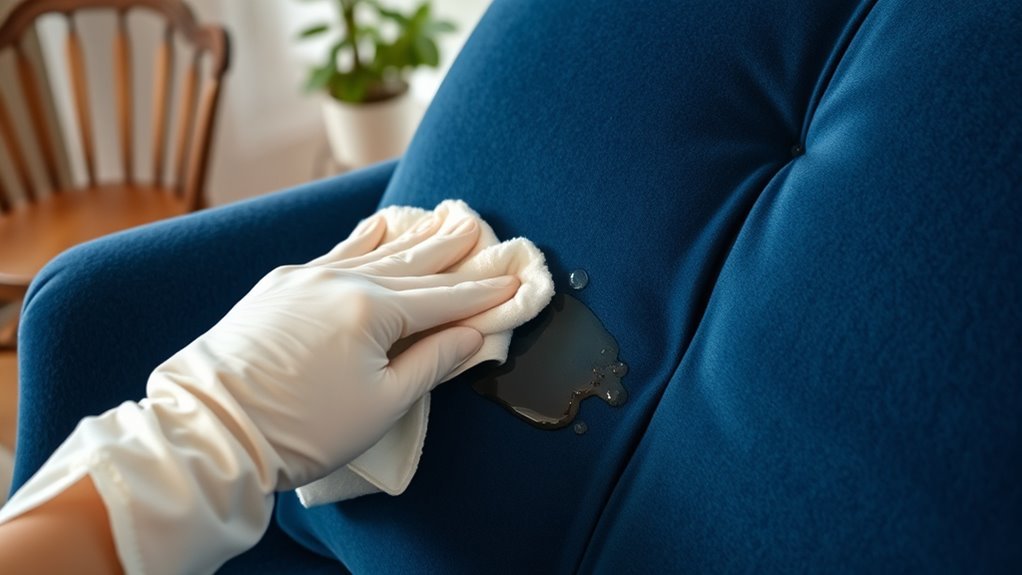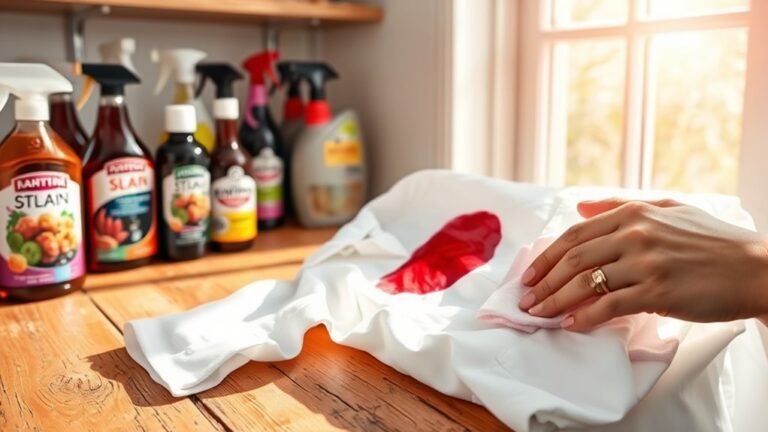How to Clean Grease Upholstery
If you get grease on your upholstery, start by blotting the excess gently with a clean cloth to avoid spreading. Sprinkle baking soda or cornstarch to absorb the oil, letting it sit for 15-30 minutes before vacuuming. Use a mild dish soap solution to break down remaining grease, then rinse carefully without soaking the fabric. For tougher stains, try a commercial cleaner made for upholstery. To protect your furniture long-term and keep it fresh, there are simple steps you can take next.
Identify the Type of Upholstery Fabric
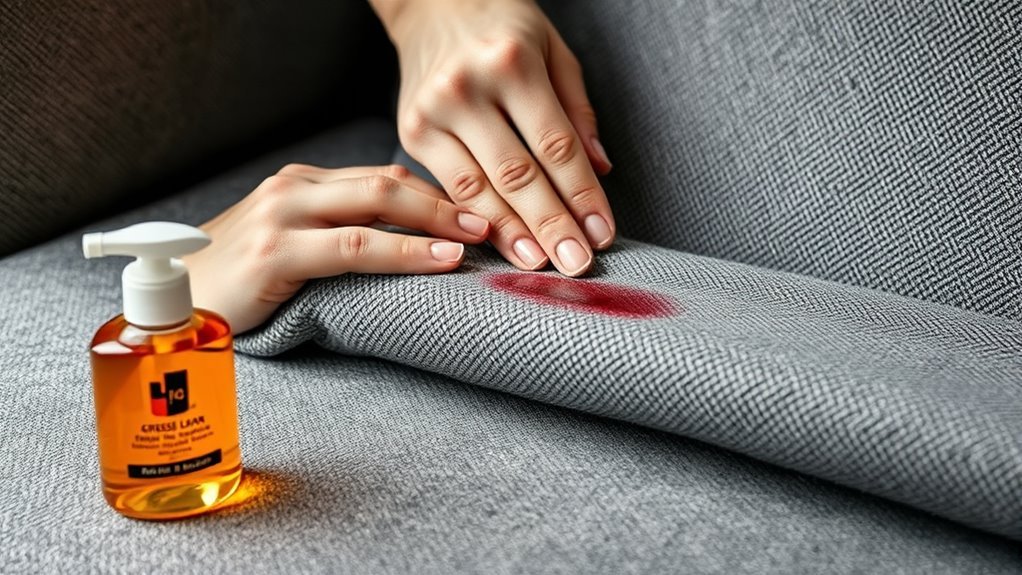
How do you know which cleaning method to use without identifying your upholstery fabric first? Recognizing different upholstery types is essential because fabric characteristics determine how they react to cleaning agents. Some fabrics, like cotton or linen, absorb liquids quickly and may shrink or stain if treated improperly. Synthetic materials, such as polyester or nylon, tend to resist stains better but might require specific detergents. Leather and suede demand even more delicate care to avoid damage. By understanding your fabric’s weave, fiber content, and colorfastness, you gain the freedom to clean confidently and effectively. Take a moment to check any tags or test a hidden spot, so you don’t risk ruining your furniture. Knowing your upholstery fabric sets the foundation for successful grease stain removal.
Gather Necessary Cleaning Supplies
Before you start cleaning, make sure you have the right tools on hand. You’ll need essential items like a soft brush, clean cloths, and a vacuum, along with recommended cleaning products suited to your upholstery type. Having these supplies ready will make the process smoother and more effective.
Essential Cleaning Tools
Although tackling grease on upholstery can seem intimidating, having the right tools makes the process much easier. To free yourself from stubborn stains, start by gathering essential cleaning tools. A set of upholstery brushes is a must—they’re designed to gently lift grease without damaging fabric fibers. Besides brushes, keep a clean, soft cloth or microfiber towel handy for blotting excess grease and moisture. You’ll also want a small bucket or bowl to mix any cleaning solutions later, plus a spray bottle for even application. Having these tools ready not only speeds up your cleaning but also gives you control over the process, helping you restore your upholstery’s look with confidence and freedom. Remember, the right tools set the foundation for success.
Recommended Cleaning Products
With your cleaning tools ready, the next step is choosing the right products to tackle grease stains effectively. You’ll want to opt for natural cleaners that are gentle on your upholstery yet powerful against grease. These eco-friendly options let you clean without worrying about harsh chemicals, giving you the freedom to refresh your space safely. Upholstery sprays designed specifically for grease removal can be a game-changer—they target stains directly and make lifting grease easier. Look for sprays that specify compatibility with your fabric type to avoid damage. Having these recommended cleaning products on hand guarantees you’re prepared to restore your upholstery’s look quickly and efficiently, keeping your home fresh and inviting without compromise.
Blot Excess Grease Without Spreading
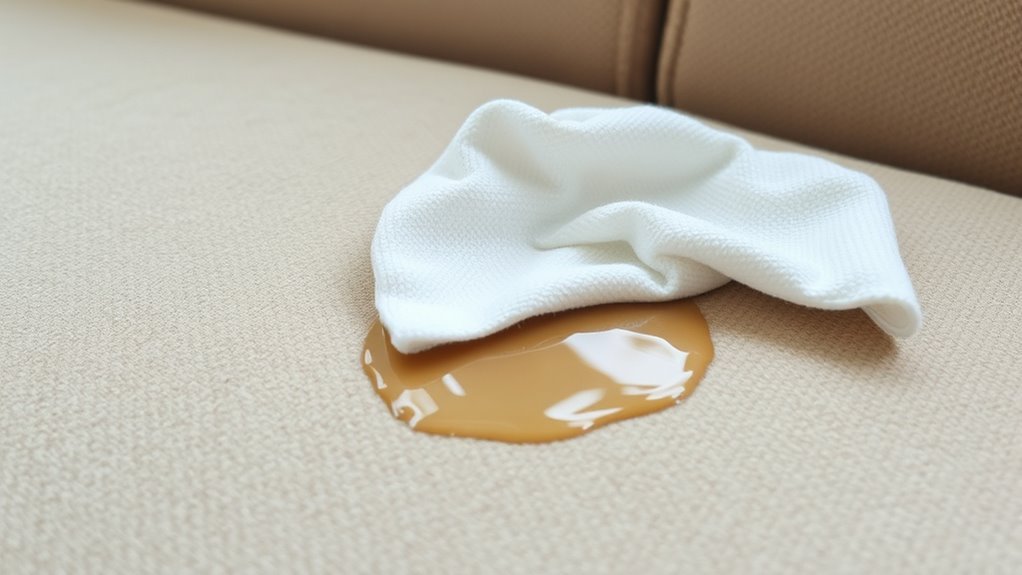
To tackle grease stains effectively, start by blotting the excess without rubbing or spreading it further. You want to use blotting techniques that focus on lifting the grease gently, not pushing it deeper or across the fabric. Grab a clean, dry cloth or paper towel and press it firmly onto the stain, allowing it to absorb the grease naturally. Avoid any scrubbing motions, as they’ll only enlarge the stain and embed the grease more. Keep switching to fresh cloth sections as they become saturated to maximize grease absorption. This simple step gives you control and prevents the stain from growing, setting you free from the worry of making things worse before moving on to deeper cleaning methods.
Apply Baking Soda or Cornstarch to Absorb Grease
Once you’ve blotted up the excess grease, applying baking soda or cornstarch can help draw out the remaining oil from your upholstery. Sprinkle a generous layer of baking soda over the stained area—the baking soda benefits include its natural absorbency and gentle cleaning power, making it perfect for delicate fabrics. Alternatively, cornstarch application works similarly by soaking up grease without harsh chemicals. Let the powder sit for at least 15 to 30 minutes so it can fully absorb the oil. Afterward, gently vacuum or brush away the powder, lifting the grease with it. This step gives you the freedom to tackle tough stains without damaging your upholstery, setting you up nicely for the next cleaning phase.
Use Dish Soap Solution to Break Down Oil
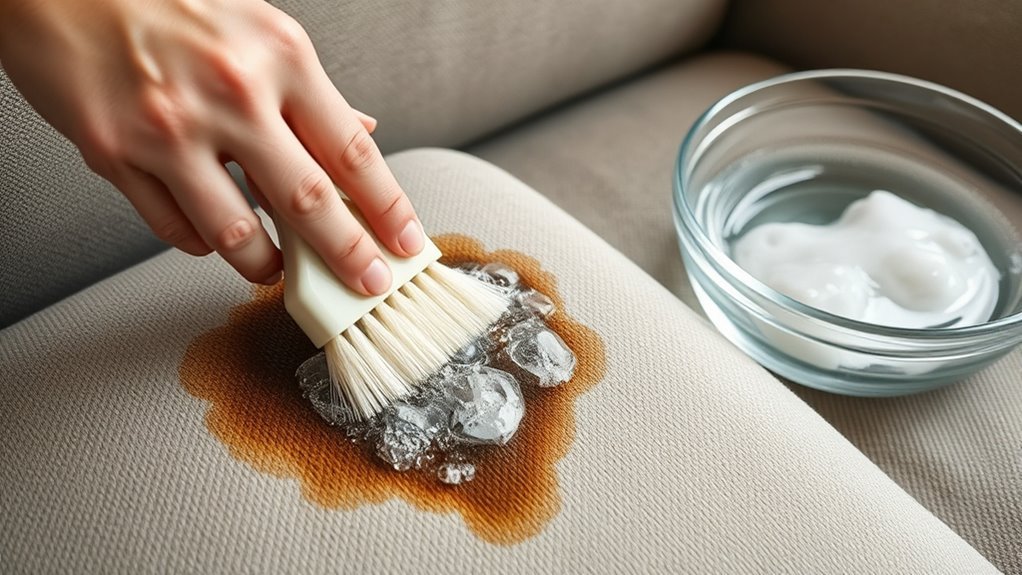
After you’ve let the baking soda or cornstarch absorb the grease, it’s time to tackle the remaining oil with a dish soap solution. Dish soap is designed to cut through grease, making it perfect for oil breakdown on your upholstery. Mix a few drops of dish soap with warm water, creating a gentle but effective cleaner. Dip a clean cloth into the solution and blot the stained area carefully—don’t scrub, as that could push the oil deeper. The dish soap will break down the oil molecules, loosening the grease from the fabric fibers. This step gives you control and freedom to refresh your upholstery without harsh chemicals or expensive cleaners, letting you restore your space with confidence.
Rinse the Treated Area Gently
Although it might be tempting to scrub the area, you’ll want to rinse the treated spot gently to avoid spreading the grease or damaging the fabric. The rinse method you choose plays a key role in effective upholstery care. Use a clean, damp cloth dipped in lukewarm water to softly blot the treated area, lifting away soap residue and loosened grease without saturating the fabric. Avoid harsh rubbing, which can push grease deeper or fray fibers. Patience is your ally here—repeat the rinse process with fresh water until no soap remains, ensuring your upholstery stays fresh and intact. Taking this gentle approach keeps your freedom to enjoy clean, comfortable furniture without risking damage or stubborn stains.
Dry the Upholstery Properly
Since moisture can damage upholstery or encourage mold growth, drying it properly is crucial. You want to guarantee your furniture stays fresh and free from any hidden dampness that could ruin your freedom to relax. Here are some effective drying techniques to take into account:
- Use a fan or portable drying equipment to increase air circulation and speed up drying.
- Open windows or doors to promote natural airflow, helping moisture evaporate faster.
- Avoid direct sunlight on delicate fabrics, which can cause fading or damage.
Use Commercial Upholstery Cleaners for Stubborn Stains
Once your upholstery is dry, it’s time to tackle those stubborn grease stains that won’t budge with basic cleaning. You’ll want to reach for commercial products designed specifically for stain removal on fabrics. These cleaners are formulated to break down tough grease without harming your upholstery.
Here’s a quick guide to choosing the right commercial product:
| Product Type | Best For |
|---|---|
| Foam Cleaners | Surface grease, quick fixes |
| Liquid Solutions | Deep grease stains, heavy soils |
| Spray Cleaners | Spot treatment, targeted stain removal |
Always test on a hidden area first to guarantee freedom from damage. Apply as directed, then blot gently. With the right commercial products, you’re free to restore your upholstery’s clean look without hassle.
Prevent Future Grease Stains on Upholstery
To keep your upholstery looking fresh, start by applying fabric protectors that repel grease. Make it a habit to clean your furniture regularly and treat any spills immediately before they set. These simple steps can save you time and effort in the long run.
Use Fabric Protectors
Although you can remove grease stains with the right cleaning methods, preventing them is always easier. That’s where fabric protectors come in—they create an invisible shield, making spills easier to clean and reducing permanent damage. Understanding fabric protectors benefits helps you appreciate their value in maintaining your upholstery’s freedom from stains.
To get the most out of fabric protectors, focus on these application techniques:
- Clean upholstery thoroughly before applying to guarantee better adhesion
- Spray evenly from a distance to cover all surfaces without saturating
- Allow complete drying time before use to maximize protection
Regular Upholstery Maintenance
Applying fabric protectors is a great step, but keeping your upholstery looking fresh means sticking to a regular maintenance routine. You want your space to feel open and worry-free, so embracing simple upholstery care habits can make all the difference. Start by vacuuming your furniture weekly to remove dust and debris that can trap grease. Rotate cushions regularly to guarantee even wear and prevent dirt buildup. Avoid eating directly on upholstered pieces to minimize grease contact. If you have pets, keep their paws clean to reduce stains. These maintenance tips help you stay ahead of grime, giving you freedom from constant deep cleans. By committing to these easy routines, you protect your investment and enjoy a cleaner, more inviting space every day.
Immediate Stain Treatment
When grease stains happen, acting quickly is key to preventing permanent damage. Taking immediate actions can save your upholstery and keep your space feeling fresh and free. You don’t have to feel trapped by stubborn stains when quick solutions are within reach. Here’s what you can do right away:
- Blot the stain gently with a clean cloth to absorb excess grease without spreading it.
- Sprinkle baking soda or cornstarch on the spot to soak up grease, then vacuum after 15 minutes.
- Apply a small amount of dish soap mixed with warm water to break down the grease, then blot with a damp cloth.
Frequently Asked Questions
Can Grease Stains Damage Upholstery Fabric Permanently?
Yes, grease stains can cause permanent damage if you don’t act quickly. You’ll want to prioritize grease removal to avoid fabric care issues that might ruin your upholstery’s look and feel. Don’t let stains set in; the longer grease stays, the harder it is to remove. Taking swift action gives you the freedom to keep your fabric fresh and your space inviting without lasting marks or damage.
Is It Safe to Use Vinegar on All Upholstery Types?
You might think vinegar’s effectiveness makes it a go-to cleaner, but it’s not safe for all upholstery types. While vinegar works great on cotton or synthetic fabrics, it can damage delicate materials like silk or leather. So, you’ll want to check your upholstery’s care label before diving in. Testing a small hidden spot first is key—you’ll keep your freedom to clean without risking permanent harm or discoloration.
How Often Should Upholstery Be Professionally Cleaned?
Funny enough, just like your car needs regular tune-ups, your upholstery benefits from professional care too. Frequency recommendations usually suggest a deep clean every 12 to 18 months, depending on use and pets. If you like freedom from stains and odors, sticking to this cleaning schedule helps keep your furniture new and inviting. Think of it as giving your space a refreshing change, so you can relax without worry.
Can Pet Hair Make Grease Stains Harder to Remove?
Yes, pet hair can make grease stains tougher to remove because it traps dirt and oils, embedding them deeper into your fabric. When you focus on pet hair removal first, you’re making upholstery maintenance way easier. Vacuum thoroughly or use a lint roller to lift hair before tackling stains. This way, you free your furniture from grime buildup, making your cleaning process smoother and your upholstery looking fresh, giving you more freedom to enjoy your space.
Are Steam Cleaners Effective for Grease Stain Removal?
Think of a steam cleaner as your trusty sword in a quest against stubborn grease stains. Its steam cleaner effectiveness lies in breaking down grease without harsh chemicals, giving you a liberating, eco-friendly way to tackle messes. For grease stain removal, steam loosens oils deep in upholstery fibers, making your cleanup feel less like a chore and more like reclaiming your space. So yes, it’s a powerful ally in your freedom fight against grime.
